|
We don't buy or sell products at hamradiomarket.com - We bring together those that do.
User Names and Passwords not required at
hamradiomarket.com. |
QRO HF-2000 Linear
Amplifier
The
big warm glowing tubes still perform. http://www.qrotec.com/
by Bob
Hutchinson, N5CNN
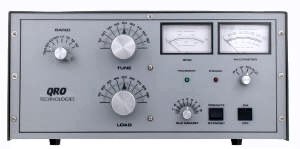 OK, let's get
this straight right away - I love the big glass tubes. I like the warm
glow. I grew up with the glowing tubes shinning their warm light into a
subdued room. As a kid I would take the cover off of anything that
had tubes so I could feel the glow. My first real stereo equipment
- - yep, tubes. Lots of tubes and covers always off. Dyna-Kit and
McIntosh.
OK, let's get
this straight right away - I love the big glass tubes. I like the warm
glow. I grew up with the glowing tubes shinning their warm light into a
subdued room. As a kid I would take the cover off of anything that
had tubes so I could feel the glow. My first real stereo equipment
- - yep, tubes. Lots of tubes and covers always off. Dyna-Kit and
McIntosh.
My amazement and adoration of the first 3-500 tube was a motivating factor in getting into Ham Radio. I have seven amplifiers with glass tubes and most of them have a pair of the 3-500s standing tall. The 3-500 tube style amplifiers are still offered by many amplifier manufacturers to satisfy the undying demand of those afflicted with OCTD, known in the medical community as Obsessive-Compulsive Tube Disorder.
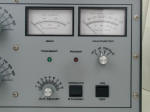 I have used and modified enough Heathkit SB220 and SB221
amplifiers to correct design or production shortcomings or to improve
performance to be qualified to review any amplifier of similar design. Our
well-equipped test bench is not equipped with a spectrum analyzer so we
don't get into that at all.
I have used and modified enough Heathkit SB220 and SB221
amplifiers to correct design or production shortcomings or to improve
performance to be qualified to review any amplifier of similar design. Our
well-equipped test bench is not equipped with a spectrum analyzer so we
don't get into that at all.
Ordering the HF-2000 and dealing with
Ray Connin, QRO owner, was truly a pleasure. Ray, KB8VU, is
easy-going and easy to talk to. The boxes came when he said they would and
I opened the larger box with the amp, sans the tubes and Peter Dahl
combination plate, filament and control transformer. Transformer and tubes
were shipped in their own boxes.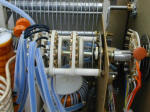
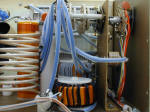 This HF-2000 was first partially disassembled and
photographed in our light tent, which was designed just for this purpose.
The photography results of the interior parts are presented here. I was
impressed with the quality of the fasteners, all stainless steel. The top
cover is 1/8" aluminum, which is about twice as thick as other amplifiers.
(More about this at end of article.)
This HF-2000 was first partially disassembled and
photographed in our light tent, which was designed just for this purpose.
The photography results of the interior parts are presented here. I was
impressed with the quality of the fasteners, all stainless steel. The top
cover is 1/8" aluminum, which is about twice as thick as other amplifiers.
(More about this at end of article.)
Big
Switch
Please note
the very robust band switch. This switch is of a higher quality and rating
than other amps having two times the power. This switch is rotated via a
fiberglass rod connecting the front of the switch to the knob. This
insulator provides an extra measure of safety. The operating knob is
normal size for Ham size linear amplifiers but could have more leverage to
operate this big band switch.
As you browse the pictures, I believe you will agree that components and circuit boards are neat, uncluttered and easy to get to and adhere to the first design considerations for an HF linear amplifier.
The product has user serviceable parts in a potentially lethal, high voltage environment.
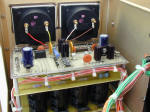 And the power supplies?
And the power supplies?
The circuit board area includes the rectifier,
filter capacitor, meter and control circuits and components. The plate
power supply is the tried and proven full wave voltage doubler design made
famous by the Heathkit SB220 and used today in over half of all new tube
type amplifiers. Rectifier is populated with the industry standard N5408,
1000 V. PIV diodes providing 5000 V. peak inverse voltage protection
capacity. Filter capacitors are 470 uh/450 V. computer grade electrolytics
in two banks for proper operation of the doubler circuit. Eight of them
provide about 55 uh filtering and a 3600 V. working capacity.
The no load voltage on the meter is 3200 V. Other secondary power from the transformer provide voltages for the requirements of metering, control, bias, soft start and QSK T/R circuits.
Vacuum relay
QSK
QRO made the
design change a while back to include their vacuum relay, full break-in
QSK circuit, of a design similar to the Rich Measures circuit, at no
additional cost. I have modified several grounded grid tube type
amplifiers (SB220) with this QSK feature. Although I am not a CW full
break-in type of guy, I can say that this feature provides wonderful VOX
enhancements for telephone-like SSB conversations.
Component
carefully inserted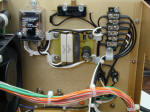
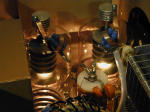
The transformer was unpacked and I was surprised
to see a rope for assistance in lifting it into the case. There is an
electrolytic capacitor in the inrush protection (soft start) circuit board
sticking out that could interfere with the insertion of the heavy
transformer. Well, I believe it would be the other way, the transformer
could just smash the little capacitor so I stood a sheet of .060 Plexiglas
up to guide the transformer properly without damaging the cap. After the
transformer is bolted in, it clears this capacitor by about 3/8 inch.
All fasteners are stainless. I inserted the 1/4-20 hex cap screws with washers from the bottom and installed washers and nuts on top. With the right tools and patience its easy. Next I mated the primary and secondary plugs and, following the manual, made sure nothing could possibly get into the box fan blades.

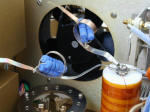 The tubes are RF
Parts private labeled Graphite type and were installed with ease into the
steel (appears to be stainless) and ceramic sockets with silver plated pin
grippers. The anode straps with parasitic suppressors were attached to the
anodes.
The tubes are RF
Parts private labeled Graphite type and were installed with ease into the
steel (appears to be stainless) and ceramic sockets with silver plated pin
grippers. The anode straps with parasitic suppressors were attached to the
anodes.
As you can see in the many pictures, everything is neat and the workmanship is superb. No shortcuts, anywhere. Whether you are a 25-yea-old Ham or Mr. Average Ham at age 59, this top quality amplifier will probably outlive you.
I installed a 15 amp 234V. type AC plug on the AC power cord. The three wires were nicely tinned for ease of proper plug installation. I hooked up the RF input from the Icom exciter and RF output to the Bird and Coaxial Dynamics watt meters, in series with the antenna switchbox. (Article about my 4x vacuum relay, remote antenna switch design soon). Then the T/R relay control and ALC feedback cable and ground.
But does it
run?
Well, let's see. On
start-up for the first time - no sounds. I found, later in life, that I
was not as indestructible as I believed in my youth. Hearing not quite up
to standards now but noisy amplifiers irritate me. QRO knows how to cool
an amplifier without fan noise. What a pleasure. I have installed several
two speed thermal switch fan controllers, with adjustable low speed, in
amplifiers attempting to bring the noise down to this level. This amp is
quiet. The tubes light up.
Bench
Our test bench is equipped with the Palstar 2000 watt fan cooled
dummy load, low pass filter, Bird 43 and Coaxial Dynamics watt meters with
2500 W. slugs and antenna switch access to 75M & 40M dipoles and 20M,
17M and 10M vertical antennas. A Palstar watt meter was used
to measure exciter drive power. I first tuned and tested each band
for function on the dummy load. All as expected. Then I went through my
systematic load test, band by band, on the dummy load. Results below
coincide with the tune up table furnished with the amplifier. The QRO was
optimized for the phone section of 160 and 80 meters. Drive signal is
CW.
| Freq. | Drive | Plate Voltage | Plate Current | Power Out |
| 3.900 Mhz | 110W | 2700V | 700MA | 1350W |
| 7.200 Mhz | 110W | 2700V | 700MA | 1400W |
| 14.200 Mhz | 110W | 2700V | 900MA | 1500W |
| 18.120 Mhz | 110W | 2700V | 800MA | 1400W |
| 21.350Mhz | 110W | 2700V | 850MA | 1350W |
| 28.400 Mhz | 110W | 2600V | 850MA | 1275W |
Grid current never exceeded 220MA in final tune during any test.
My tests on the air were similar to the above but this amplifier liked my 75 meter antenna and put 1500 watts into it. On the air test for 15 meters was done using the 40 meter dipole. In all testing the HF-2000 performed flawlessly. The ALC performed just like the manual said it would. ALC is not really needed with 100 watt class transceivers driving two 3-500 tubes.
Control operations are smooth and precise. The reduction drives on the load and tune capacitors make tuning easy. Retuning by the numbers is a snap.
Conclusion
Superb legal limit HF linear amplifier. If
there is a dual 3-500Z amplifier that can top the HF-2000 in design,
quality of construction, quality of components and quiet and rugged
performance, this Ham has no knowledge of it. If I could have just ONE
amplifier with my sweetheart 3-500 tubes - it would be the QRO HF2000.
Also, QRO has one of the best web sites in the industry.

 Other Conclusion
Other Conclusion
At the beginning of this article I mentioned that I love the
warm, glowing tubes and that, in the past, I had removed covers so I could
feel the warm, glowing tubes. Well, after all the testing was
done on this fine
piece of equipm ent - - - I, - - I, - - just couldn't help myself - - I
concluded that my personal
esteem, personal growth and psychological well-being would benefit if
I whacked the cover a bit to
suit my adoration of warm,
glowing tubes. Since I have been whacking aluminum and steel all my life I
knew exactly what to do. I cut a BIG hole in the 1/8" thick cover of the
RF compartment and covered it on the under side with a sturdy flat of
stainless steel expanded metal. A nice, professional job, if I do say so
myself. I wanted to see the big tubes for personal mental health reasons
and now I can. (See before and after.)
ent - - - I, - - I, - - just couldn't help myself - - I
concluded that my personal
esteem, personal growth and psychological well-being would benefit if
I whacked the cover a bit to
suit my adoration of warm,
glowing tubes. Since I have been whacking aluminum and steel all my life I
knew exactly what to do. I cut a BIG hole in the 1/8" thick cover of the
RF compartment and covered it on the under side with a sturdy flat of
stainless steel expanded metal. A nice, professional job, if I do say so
myself. I wanted to see the big tubes for personal mental health reasons
and now I can. (See before and after.)
No, I have not asked Ray at QRO to change his design.
Bob Hutchinson,
N5CNN
President and Founder
Wireless Industry Association
mailone@wirelessindustry.com
713
467-0077
If you would like to publish
an article here contact Bob Hutchinson, N5CNN: mailto:mailone@wirelessindustry.com.




